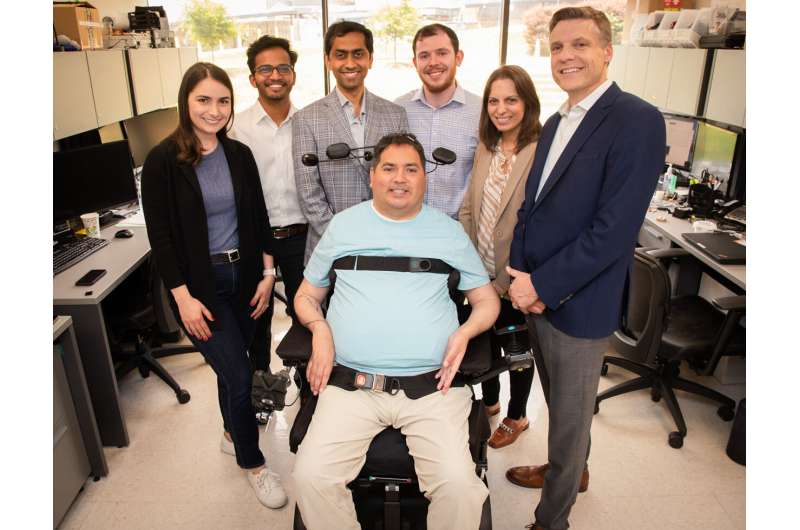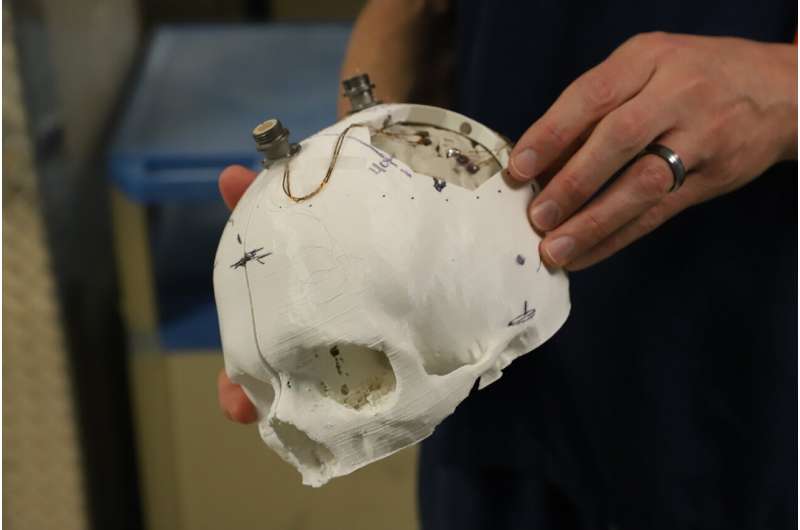
In a first-of-its-kind clinical trial, bioelectronic medicine researchers, engineers and surgeons at Northwell Health's The Feinstein Institutes for Medical Research have successfully implanted microchips into the brain of a man living with paralysis, and have developed artificial intelligence (AI) algorithms to re-link his brain to his body and spinal cord.
This double neural bypass forms an electronic bridge that allows information to flow once again between the man's paralyzed body and brain to restore movement and sensations in his hand with lasting gains in his arm and wrist outside of the laboratory. The research team unveiled the trial participant's groundbreaking progress four months after a 15-hour open-brain surgery that took place on March 9 at North Shore University Hospital (NSUH).
"This is the first time the brain, body and spinal cord have been linked together electronically in a paralyzed human to restore lasting movement and sensation," said Chad Bouton, professor in the Institute of Bioelectronic Medicine at the Feinstein Institutes, vice president of advanced engineering at Northwell Health, developer of the technology and principal investigator of the clinical trial.
"When the study participant thinks about moving his arm or hand, we 'supercharge' his spinal cord and stimulate his brain and muscles to help rebuild connections, provide sensory feedback, and promote recovery. This type of thought-driven therapy is a game-changer. Our goal is to use this technology one day to give people living with paralysis the ability to live fuller, more independent lives."
Paralyzed from the chest down, Keith Thomas, 45, of Massapequa, NY, is the first human to use the technology. During the height of the pandemic, on July 18, 2020, a diving accident caused Mr. Thomas to suffer injury at the C4 and C5 level of the vertebrae in his spine, leaving him unable to move and feel from the chest down.
"There was a time that I didn't know if I was even going to live, or if I wanted to, frankly. And now, I can feel the touch of someone holding my hand. It's overwhelming," said Mr. Thomas.
Over a hundred million people worldwide live with some form of movement impairment or paralysis. This clinical trial aims to restore lasting physical movement—outside of the research lab—and re-establish the sense of touch.
Feinstein Institutes' researchers and clinicians, including Santosh Chandrasekaran, Ph.D. and Adam Stein, MD, chair of physical medicine and rehabilitation at Northwell Health, spent months mapping Mr. Thomas' brain using functional MRIs to help pinpoint the areas responsible for both arm movement and for the sensation of touch in his hand.
Armed with that information, surgeons performed a 15-hour surgery at NSUH, during parts of which the study participant was awake and giving surgeons real-time feedback. As they probed portions of the surface of his brain, Mr. Thomas would tell them what sensations he was feeling in his hands.
"Because we had Keith's images, and he was talking to us during parts of his surgery, we knew exactly where to place the brain implants," said Ashesh Mehta, MD, Ph.D., professor at the Feinstein Institutes' Institute of Bioelectronic Medicine, director Northwell's Laboratory for Human Brain Mapping and the surgeon who performed the brain implant. "We inserted two chips in the area responsible for movement and three more in the part of the brain responsible for touch and feeling in the fingers."
Back in the lab, through two ports protruding from Mr. Thomas' head, he connects to a computer that uses AI to read, interpret and translate his thoughts into action, known as thought-driven therapy and the foundation of the double neural bypass approach.
The bypass starts with Mr. Thomas' intentions (i.e., he thinks about squeezing his hand), which sends electrical signals from his brain implant to a computer. The computer then sends signals to highly flexible, non-invasive electrode patches that are placed over his spine and hand muscles located in his forearm to stimulate and promote function and recovery.
Tiny sensors at his fingertips and palm send touch and pressure information back to the sensory area of his brain to restore sensation. This two-arm electronic bridge forms the novel double neural bypass aimed at restoring both movement and the sense of touch. In the lab, Mr. Thomas can now move his arms at will and feel his sister's touch as she holds his hand in support. This is the first time he has felt anything in the three years since his accident.
Remarkably, researchers say Mr. Thomas is already starting to see some natural recovery from his injuries thanks to this new approach, which could reverse some of the damage for good. His arm strength has more than doubled since enrolling in the study and he is beginning to experience new sensations in his forearm and wrist, even when the system is off.

Previous research by Prof. Bouton, and later, by other groups, used a single neural bypass to help people move paralyzed limbs again with their thoughts.
In those cases, doctors implanted one or more microchips in the brain that bypassed the spinal cord injury altogether and used stimulators to activate target muscles. However, that approach only worked while participants were hooked up to computers, often only available in laboratories, and did not restore movement and feeling in the actual limb while promoting plasticity for long-lasting natural recovery.
The hope is that the brain, body and spinal cord will relearn how to communicate, and new pathways will be forged at the injury site thanks to the double neural bypass, similar to how a kidney can regenerate to overcome trauma or disease.
"Millions of people live with paralysis and loss of feeling, with limited options available to improve their condition, " said Kevin J. Tracey, MD, president and CEO of the Feinstein Institutes and Karches Family Distinguished Chair in Medical Research. "Prof. Bouton and his team are committed to advancing new bioelectronic technologies and open new clinical paths to restore movement and sensation."
Provided by The Feinstein Institutes for Medical Research at Northwell Health
Citation: For the first time researchers restore feeling and lasting movement in man living with quadriplegia (2023, August 1) retrieved 1 August 2023 from https://ift.tt/Gw4gfP1
This document is subject to copyright. Apart from any fair dealing for the purpose of private study or research, no part may be reproduced without the written permission. The content is provided for information purposes only.
"lasting" - Google News
August 01, 2023 at 09:51PM
https://ift.tt/a6HMgJO
For the first time researchers restore feeling and lasting movement in man living with quadriplegia - Medical Xpress
"lasting" - Google News
https://ift.tt/w5B8gHE
Shoes Man Tutorial
Pos News Update
Meme Update
Korean Entertainment News
Japan News Update
Bagikan Berita Ini














0 Response to "For the first time researchers restore feeling and lasting movement in man living with quadriplegia - Medical Xpress"
Post a Comment